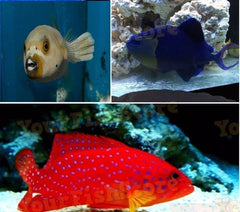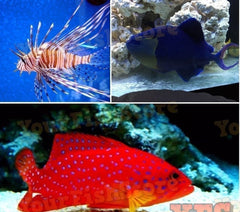(X2) Black Ice Clown Fish (Pair) Med - (X2) Mandarin Gobies - (X1) Yellow Tang

(X2) BLACK ICE CLOWNFISH (PAIR) MED - (x2) MANDARIN GOBIES - (x1) YELLOW TANG SMALL
PACKAGE
*********************************************************************
(X2) BLACK ICE CLOWNFISH (PAIR) MED
*Tank Raised *Free Shipping *Premier Breeders *Healthy & Eating Aggressive
All live stock is shipped FEDEX PRIORITY OVERNIGHT by 10:30am in most areas (USA only). All shipment include Styrofoam for insulation and heat/cold pack to guarantee live delivery.
Buy from an Official Breeder. We thoroughly inspect each pair before they are sent off to their new home. Each Clown Fish is held for 90 days before they leave our facility insure proper clown gain and aggressive eating habits.
We typically feed all of our clown fish micro .5mm pellets soft/dry, and copepods.
Minimum Tank Size: 20 gallons
Care Level: Easy
Temperament: Peaceful
Reef Compatible: Yes
Water Conditions: 72-78° F, dKH 8-12, pH 8.1-8.4, sg 1.020-1.025
Max. Size: 3"
Color Form: Black, Orange, White
Diet: Omnivore
Compatibility: View Chart
Origin: Captive-Bred - USA
Family: Pomacentridae
This buy, is for two singles that have been paired up together. Check out would be for 1 pair.
Beautiful Clown Fish. The clowns are approx 1" - 1 3/4".
The Black Ice Clownfish is a unique cross between our Premium Snowflake Ocellaris Clownfish and our ultra-black Darwin Ocellaris Clownfish. Like the Snowflake Ocellaris Clownfish, the Black Ice Clownfish has three white body stripes that are exaggerated and have irregular shapes and patterns. The body color is a beautiful orange- brown. The color will darken with maturity. No two fish are the same and this designer clownfish has become increasingly popular for its distinctiveness.
Temperament & Captive Care
The temperament and captive care requirements for the Black Ice Clownfish are very similar to that of the regular Ocellaris Clownfish. It is relatively peaceful and hardy. They thrive in saltwater aquariums with or without an anemone present.
Feeding
Most clownfish are omnivorous feeders, meaning that they will consume a variety of different food types. In nature the diet of clownfish consists of crustaceans (such as copepods and amphipods), algae, polychaete worms, and leftovers from the anemone’s meal. Our captive bred fish are conditioned to eat a variety of aquarium diets including pellets, flake food, frozen Mysis shrimp, and frozen brine shrimp.
Aquarium Host Anemones
Black Ice Clownfish will readily accept a wide variety of host anemones and many hobbyists keep them with the popular and hardy Bubble Tip Anemone (Entacmaea quadricolor). As a reference, the natural host anemones of the regular Ocellaris Clownfish are Magnificent Sea Anemone (Heteractis magnifica), Giant Carpet Sea Anemone (Stichodactyla gigantean) and Merten's Carpet Sea Anemone (Stichodactyla mertensii).
******************************************
GREEN MANDARIN GOBY - SALTWATER FISH -FREE SHIPPING
*Medium Size Approx 1 1/2" - 2 1/2" Each
Minimum Tank Size: 30 gallons
Care Level: Moderate
Temperament: Peaceful
Reef Compatible: Yes
Water Conditions: 72-78° F, dKH 8-12, pH 8.1-8.4, sg 1.020-1.025
Max. Size: 4"
Mandarin Gobies, also referred to as Mandarin Dragonets, Mandarinfish, Mandarins, and Psychedelic Gobies, are by-and-by one of the most beautiful and exotic types of fish on the market. Thanks to their mesmerizing stripes and dizzying colors, Mandarins are a super-hot commodity among reef hobbyists.
The Mandarin, with vibrant blue-green rivers of pigment running across its body, is an unmistakable fish that’s sure to be the highlight of your aquarium or refugium. They originate from the warm pacific waters in and around the Indonesia, the Philippines, and Australia.
Despite the fact that Mandarin Gobies are such a staple in the reefing enthusiast’s collection, they still reign supreme as one of the hardest types of fish to keep alive. Letting them thrive is a different story altogether.
The way the Mandarin Goby feeds in the wild (eating large amounts of live shrimp, copepods, and worms) makes for a tough time recreating the conditions. Malnourishment is one of the most common fates to befall a captive Mandarin. Much of the time, they won’t even touch the food you put out for them.
Does that mean you should give up on the Goby and pop for an easier, less finicky fish? Absolutely not. With a little TLC and the right, very specific conditions, Mandarin Gobies can be a breeze to take care of. As gorgeous as they are, you’ll be glad you made the effort.
Introduce this beautiful fish and draw attention to your aquarium. The Green Mandarin Dragonet can never be compared to any other fish. It has the most attractive and vivid coloration and pattern. The Green Mandarin Dragonet features scaleless body in green with orange wavy lines across it. Not only this, its tail is bright red with blue edging. The Green Mandarin Dragonet is also known as Psychedelic fish due to its bizarre coloration. The male fish is larger and also features a large pointed dorsal fin. Although, more often it is named as Mandarin Goby, but they are not gobies, rather they belong to Dragonets family. The Green Mandarin Dragonet is found in groups or pairs, and mainly on sandy bottoms between reef crests, and is indigenous to Philippine area. It is one of the most commonly sold fish, and at the same time it is most delicate in nature and needs care to maintain its longevity, due to its feeding habits. It mainly feeds on live amphipoda and copepods, and these can be found only in larger reef tanks. The Green Mandarin Dragonet is very stringent in eating habits, as some of them can take even frozen foods. It basically use the front fins while looking for the food. The Green Mandarin Dragonet takes lot of time to get adjusted to a captive diet. It is extremely docile as well as non-aggressive, which makes it safe to keep in any aquarium along with other inhabitants. Due to its thick slime covering, it is resistant to parasitic diseases.
******************************************
x1 YELLOW TANG PACKAGE - SMALL SIZE - APPROX 1" - 2" EACH - SALTWATER FISH
Minimum Tank Size: 100 gallons
Care Level: Easy
Temperament: Semi-aggressive
Reef Compatible: Yes
Water Conditions: 72-78° F, dKH 8-12, pH 8.1-8.4, sg 1.020-1.025
Max. Size: 8"
Color Form: Yellow
Diet: Herbivore
The Yellow Tang fish will brighten up any reef or fish-only tank. This saltwater fish is a member of family Acanthuridae and has a beautiful oval shaped body possessing a single pastel-like yellow color along with long continuous dorsal, anal fins and crescent tailfins. It has sharp white razor spur near the tail, which it uses during fights and also to establish itself over other fishes. Known as an active swimmer, it will glide through the aquarium eating algae simultaneously and at night it beds down on the reefs or live rocks. Fairly resistant to diseases, the Yellow Tang is relatively easy to care for. It can be housed in groups of 3 or more as a shoal, or singly. This fish should be kept in an aquarium with at least 30 gallons of water and good room for swimming. It is highly recommended to have only one Tang to minimize aggression in the aquarium. Adult males tend to be larger than females and with its long snout-like mouth it can easily feed on algae and seaweeds that suffocate corals. The Yellow Tang has a sharp spine located near its tail, which it uses for protection. The Yellow Tang will surely draw attention to your home tank. As a matter of fact, this fish is among the most popular of all marine fish. The Yellow Tang is very active and loves to swim all over with curiosity. It is peace loving and non-aggressive when kept with dissimilar species.
Though most common to the reefs of Hawaii, the Yellow Hawaiian Tang's natural habitat is actually widespread throughout Indonesia and the Great Barrier Reef. The Yellow Hawaiian Tang is also known as the Yellow Sailfin Tang or Yellow Surgeonfish. For best care, it should be housed in an aquarium of at least 100 gallons with ample room to swim. Like other Tangs, this member of the Acanthuridae family demonstrates territorial aggression towards its own species, or Tangs in general. Therefore, it is best to keep just one Yellow Hawaiian Tang per aquarium, unless multiple Yellow Hawaiian Tangs are introduced into the system simultaneously.

QUESTIONS & ANSWERS
Have a Question?
Be the first to ask a question about this.














